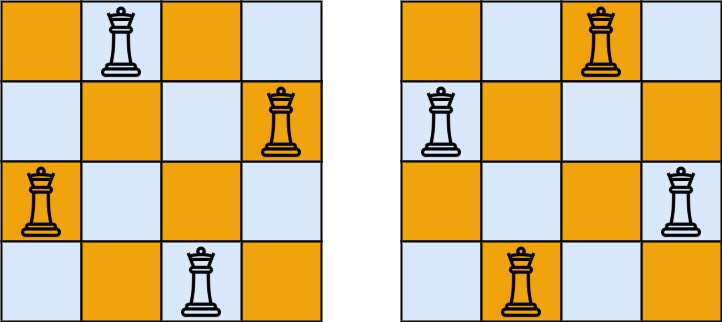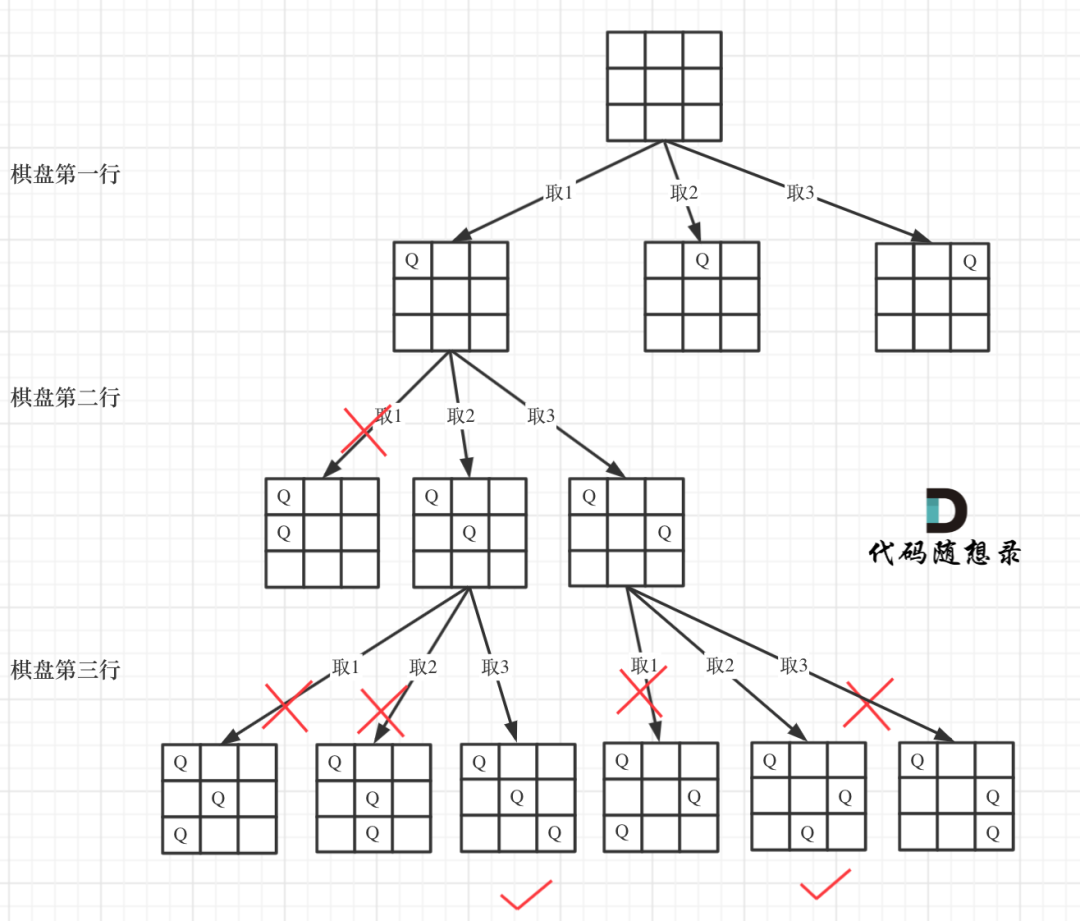Topic
- Backstracking
Description
https://leetcode.com/problems/n-queens/
The n-queens puzzle is the problem of placing n queens on an n x n chessboard such that no two queens attack each other.
Given an integer n, return all distinct solutions to the n-queens puzzle.
Each solution contains a distinct board configuration of the n-queens’ placement, where 'Q'and '.' both indicate a queen and an empty space, respectively.
Example 1:

Input: n = 4
Output: [[".Q..","...Q","Q...","..Q."],["..Q.","Q...","...Q",".Q.."]]
Explanation: There exist two distinct solutions to the 4-queens puzzle as shown above
Example 2:
Input: n = 1
Output: [["Q"]]
Constraints:
1 <= n <= 9
Analysis
题目分析
n皇后问题是回溯算法解决的经典问题。
首先来看一下皇后们的约束条件:
- 不能同行
- 不能同列
- 不能同斜线
确定完约束条件,来看看究竟要怎么去搜索皇后们的位置,其实搜索皇后的位置,可以抽象为一棵树。
下面用一个3 * 3 的棋牌,将搜索过程抽象为一颗树,如图:
注意,为了方便理解,暂时屏蔽皇后们“不能同斜线”的约束条件。

从图可看出,二维矩阵中矩阵的高就是这颗树的高度,矩阵的宽就是树型结构中每一个节点的宽度(有多少个子节点)。
那么我们用皇后们的约束条件,来回溯搜索这颗树,只要搜索到了树的叶子节点,说明就找到了皇后们的合理位置了。
回溯三弄
根据经典回溯模板编程:
void backtracking(参数) {
if (终止条件) {
存放结果;
return;
}
for (选择:本层集合中元素(树中节点孩子的数量就是集合的大小)) {
处理节点;
backtracking(路径,选择列表); // 递归
回溯,撤销处理结果
}
}
函数签名
List<String> rows:当前遍历行前的皇后摆法。int lengthOfSide:棋盘单边有多少格,也就是N皇后的N。int depth:目前递归深度,它的最大值是lengthOfSide。List<List<String>> result:存放符合要求N皇后摆法。
代码如下:
private void backstracking(List<String> rows, int lengthOfSide, int depth, List<List<String>> result) {
}
终止条件
回看题目分析的例图,当递归到棋盘最底层(也就是叶子节点)的时候,就可以收集结果并返回了。
代码如下:
if (rows.size() == lengthOfSide) {
result.add(new ArrayList<>(rows));
return;
}
遍历过程
首先,验证皇后摆法是否合法,皇后们不能同行,同列,同斜线,代码如下:
private boolean isValid(List<String> rows, int row, int col, int lengthOfSide) {
// 上方向
for (int i = row - 1; i > -1; i--) {
if (rows.get(i).charAt(col) == 'Q')
return false;
}
// 左上斜线方向
for (int i = row - 1, j = col - 1; i > -1 && j > -1; i--, j--) {
if (rows.get(i).charAt(j) == 'Q')
return false;
}
// 右上斜线方向
for (int i = row - 1, j = col + 1; i > -1 && j < lengthOfSide; i--, j++) {
if (rows.get(i).charAt(j) == 'Q')
return false;
}
return true;
}
然后,生成含有一个皇后字符串行,代码如下:
private String makeRow(int index, int lengthOfSide) {
StringBuilder sb = new StringBuilder();
for (int i = 0; i < lengthOfSide; i++) {
sb.append(i == index ? 'Q' : '.');
}
return sb.toString();
}
最后,遍历过程:
for (int i = 0; i < lengthOfSide; i++) {
if (isValid(rows, depth, i, lengthOfSide)) {
//检测皇后放置第depth行,第i列,是否合法
rows.add(makeRow(i, lengthOfSide));//放置符合要求皇后所在字符串行
backstracking(rows, lengthOfSide, depth + 1, result);
rows.remove(rows.size() - 1);//回溯
}
}
最终代码
请移步至Submission。
参考资料
Submission
import java.util.ArrayList;
import java.util.List;
public class NQueens {
public List<List<String>> solveNQueens(int n) {
List<List<String>> result = new ArrayList<>();
List<String> rows = new ArrayList<>();
backstracking(rows, n, 0, result);
return result;
}
private void backstracking(List<String> rows, int lengthOfSide, int depth, List<List<String>> result) {
if (rows.size() == lengthOfSide) {
result.add(new ArrayList<>(rows));
return;
}
for (int i = 0; i < lengthOfSide; i++) {
if (isValid(rows, depth, i, lengthOfSide)) {
rows.add(makeRow(i, lengthOfSide));
backstracking(rows, lengthOfSide, depth + 1, result);
rows.remove(rows.size() - 1);
}
}
}
private String makeRow(int index, int lengthOfSide) {
StringBuilder sb = new StringBuilder();
for (int i = 0; i < lengthOfSide; i++) {
sb.append(i == index ? 'Q' : '.');
}
return sb.toString();
}
private boolean isValid(List<String> rows, int row, int col, int lengthOfSide) {
// 上方向
for (int i = row - 1; i > -1; i--) {
if (rows.get(i).charAt(col) == 'Q')
return false;
}
// 左上方向
for (int i = row - 1, j = col - 1; i > -1 && j > -1; i--, j--) {
if (rows.get(i).charAt(j) == 'Q')
return false;
}
// 右上方向
for (int i = row - 1, j = col + 1; i > -1 && j < lengthOfSide; i--, j++) {
if (rows.get(i).charAt(j) == 'Q')
return false;
}
return true;
}
}
Test
import static org.junit.Assert.*;
import static org.hamcrest.CoreMatchers.*;
import static org.hamcrest.MatcherAssert.assertThat;
import java.util.Arrays;
import org.hamcrest.collection.IsEmptyCollection;
import org.junit.Test;
public class NQueensTest {
@Test
public void test() {
NQueens obj = new NQueens();
assertThat(obj.solveNQueens(1), is(Arrays.asList(Arrays.asList("Q"))));
assertThat(obj.solveNQueens(3), IsEmptyCollection.empty());
assertThat(obj.solveNQueens(4), is(Arrays.asList(Arrays.asList(".Q..","...Q","Q...","..Q."), //
Arrays.asList("..Q.","Q...","...Q",".Q.."))));
}
}